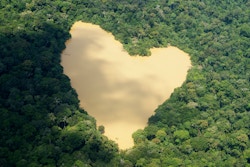Saving the rainforest
To solve the climate and nature crises, we must save the rainforest. And size matters.
By Rainforest Foundation Norway.

Today, there are nearly 10 million square kilometers of tropical rainforest in the world.
1/3 of the world's original rainforests is gone and 1/3 is damaged. 1/3 is still intact, unharmed by human activity.

But the rainforests are disappearing at an alarming rate.
In some places, the rainforest is approaching an irreversible tipping point.
But there is still time. If we scale up our efforts.
It is important to save all rainforests. However, to solve the nature and climate crises – size matters. That is why Rainforest Foundation Norway focuses on the three largest, contiguous rainforests left on the planet:

The Amazon
58% of all remaining tropical rainforest is found in the Amazon in South America. The Amazon has 3.8 million square kilometers of intact rainforest.
It is by far the largest rainforest in the world, covering nine countries.
We work in Brazil, Peru and Colombia.

The Congo Basin
The second largest remaining rainforest is in Central Africa.
The Congo Basin stretches across six countries.
We work in The Democratic Republic of the Congo (DRC). The DRC hosts 62% of the rainforest in The Congo Basin, where 818,000 square kilometers remain intact.

Southeast Asia & Oceania
With their incredibly diverse fauna and flora, the islands of Indonesia and New Guinea are biological hotspots on Earth.
New Guinea has the third largest contiguous rainforest in the world, where 773.000 square kilometers remain intact.
The island of New Guinea is shared by two countries: Indonesia in the west and Papua New Guinea in the east. We work in both.

Human activity does not just make the rainforests shrink.
Infrastructure and roads, logging, mining and agriculture fragments them into isolated patches.
That is a threat in itself.
The size of the rainforest is directly related to its ability to maintain ecological balance, support biodiversity and provide life-sustaining ecosystem services.
If we lose the last contiguous rainforests, we lose the fight against climate change and biodiversity loss.
Here is why size matters in the preservation of rainforest:

Photo: Shutterstock
Habitat diversity
Large, contiguous rainforests contain a wide variety of habitats, supporting a high diversity of plant and animal species. Smaller fragments of forest cannot support the same level of biodiversity.

Photo: Araquem Alcantara
Species range
Many species require large territories or specific conditions to survive. A large, contiguous forest allows species to move and find suitable habitats, which is critical for their survival, especially in changing conditions.
2. Ecosystem services

Photo: Shutterstock
Climate regulation
Rainforests play a significant role in regulating the global climate by storing large amounts of carbon. A larger forest has a greater capacity to absorb and store carbon, helping mitigate climate change.

Photo: Araquem Alcantara
Water cycle maintenance
Large, contiguous rainforests help maintain the local and regional water cycle by influencing precipitation patterns. They contribute to cloud formation and rainfall, which are essential for both the forest itself and the surrounding regions.
3. Resilience to environmental changes

Photo: Araquem Alcantara
Buffer against disturbances
Large, contiguous forests are more resilient to disturbances like storms, droughts, or human activities. They can absorb these impacts without collapsing, whereas smaller fragments are more vulnerable to dieback and destruction and can burn more easily.

Photo: Thomas Marent
Genetic diversity
In a larger forest, the genetic diversity of species is greater, making populations more resilient to diseases, pests, and environmental changes. This is crucial for the long-term survival of species.
4. Fragmentation and edge effects

Photo: Kamikiá Kisêdjê/AIK/RFN
Edge effects
When a rainforest is fragmented into smaller patches, the edges of these patches experience different conditions (e.g., more light, wind, higher temperatures and less humidity) compared to the interior. These edge effects can degrade the habitat, making it less suitable for many species.

Photo: Rogerio Assis/ISA
Sustainable use
Large, contiguous forests can support sustainable use such as selective logging or harvesting of non-timber forest products without significant ecological damage. Smaller areas are less capable of withstanding such pressures and are more likely to be overexploited.

Photo: Johan Wildhagen
Isolated peoples
The vast Amazon rainforest offers protection to Indigenous groups living in voluntary isolation from the outside world. It is their human right to live as they choose. Unwanted contact can bring disease and cultural decline, threatening their survival and way of life.
How we work
Recognition of Indigenous peoples’ rights to their traditional lands has proven extremely effective in protecting the rainforest. For that reason, human rights are at the heart of Rainforest Foundation Norway’s approach to preserving the last, contiguous rainforests on three continents.
The key to Rainforest Foundation Norway’s impact is our over 60 local partners. The combination of our size, credibility, and long-standing network of local partners enables us to deliver tangible results.

Halting deforestation and protecting rainforests is at the core of any scenario to avoid the worst of climate change and pass a healthy, nature-positive planet to generations to come.
We have the solutions. Let’s implement them together.
Toerris Jaeger, executive director of Rainforest Foundation Norway







